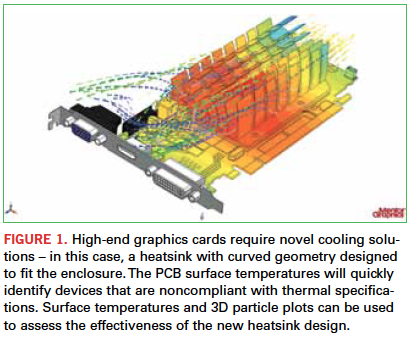Cool Runnings
The ongoing push to integrate mechanical and electrical design has now extended to electronics cooling simulation.
The latest electronics cooling simulation software has successfully integrated mechanical and board-level tools inside a common user interface. In doing so, Mentor Graphics has tackled two of today’s trends: electronic challenges and geometric complexity.
“One particular challenge is that EDA systems deal with 2D representations of the electronics because both IC and PCB design are done using schematics,” Mentor says. “PCB design tools require only the component layout and often do not contain even the most basic geometric information about the components such as component height. Detailed information about the internal geometry of the chip packages is typically unavailable.”
In developing FloTherm XT, Mentor combined the electronics cooling platform of its FloTherm thermal analysis software and Concurrent Computational Fluid Dynamic (Concurrent CFD) technology from its FloEFD product. The interface is fully configurable and scalable, adaptable to design project changes.
The new software’s library of models handles imported or CAD-generated geometries, and automatic meshing and data convergence reduce execution times. FloTherm XT also integrates with PCB design flows to reduce data translation and errors.
Mentor says the new tool enables earlier virtual prototyping, fewer design iterations, and advanced “what-if” analysis for improved product quality and faster time-to-market.
One issue is scale disparity, or the difference between the size of the physical product and that of the components and circuitry. The presence of small gaps, in the casing for example, can have a profound effect on electronics cooling, Mentor says.
This calls for behavioral models when the geometry cannot be represented directly within the simulation, as is usually the case with PCB traces on multilayer PCBs, and compact thermal models (CTMs) for IC packages to avoid having to model the internal geometry, which is often unknown.
Traditionally, thermal design has been done alongside electronic design. The use of high performance computing (HPC) infrastructure for CFD has been far less than in other industry sectors. But in electronics cooling, increased simulation precision does not translate into improved product quality. The quality of the simulation model is limited by far greater uncertainty in the input data.
For electronics cooling applications, issues relating to turbulence modeling, are rarely, if ever, the largest source of error in the results, Mentor says. It is more likely to be uncertainties in power dissipation, materials, flow rates, or interface resistances. However, turbulence can be a source of concern for some more specialized designs. The new software provides options for laminar, transitional and turbulent flows, but limits the turbulence models that are available to avoid confusion. It makes use of a general two-equation model combined with a proprietary immersed boundary treatment for near-wall effects that smoothly transitions between the different flow regimes, resulting in benchmark results said to be appropriate for electronics applications. It interfaces with existing EDA tools, and simulations can be started at the conceptual stage and continue through to implementation.

Mike Buetow is editor in chief of PCD&F (pcdandf.com); This email address is being protected from spambots. You need JavaScript enabled to view it..




